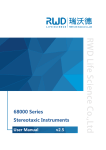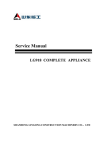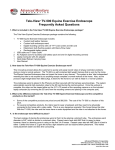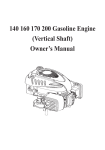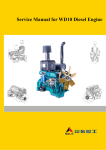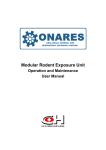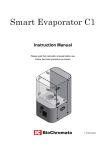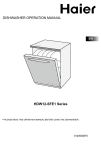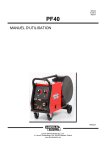Download Small Animal Ventilator, Model 405 & 407
Transcript
Model 405 &407 Small Animal Ventilator User Manual v3.5 First of all, sincerely thanks for selecting the RWD405 or RWD407 small animal ventilator made by RWD company. Please read this instruction manual and all other auxiliary materials carefully before installing and using the product, which will be helpful to work with it better. RWD has been always dedicated to improving the product function and the service quality, and will reserve the rights to revise the products itself and contents described in the instruction manual at any time without notice in advance. If you find the practical situations about the supplied goods do not agree with the contents described in the manual, or if you want to get the newest information and have any questions and idea about our products and service, please visit our web site as follows or contact us immediately. Contents Product Introduction ................................................................................ 1 System Configurations ............................................................................. 2 Installation ................................................................................................. 3 Safety Warning ......................................................................................... 5 Operation ................................................................................................... 6 Maintenance & Care ................................................................................ 8 Warranty ................................................................................................... 9 Product Introduction RWD small animal ventilators (RWD405 & RWD407) are two new types of volume-controlled ventilators especially designed for mice and neonatal rats, or adult rats, hamsters, rabbits, cats, small dogs and so on with the body weight of below 5kg. They are driven by motor and controlled by drive circuit, it could output regular airflow into the animals’ lung and enable it to breath. We use motor, reducer and controller as critical component, and do not need external High-pressure gas supply. LED screen displays realtime respiratory rate and postivve end-expiratory pressure(PEEP). All these characteristics provide the instrument low-noise, accuracy control, high stability and user-friendly control. Specifications: Cat No. RWD 405 RWD407 Respiratory Rate 18-150 times per minute 18-150 times per minute Tidal Volume 0.1-1.0cc 0.5 - 5cc (for small cylinder) 3 - 30cc (for large cylinder) 1 System Configurations 1. RWD 405 small animal ventilator (for mice or neonatal rats) (1) Control Unit (including one 0.1-1.0cc cylinder) (2) 405K mice ventilator accessory kit (including 1.5mm ID medical silicone tube, 1/16" Y-three way valve, 1/16" Luer male connector and 20G mice tracheal tube) 2. RWD 407small animal ventilator (for adult rats, hamsters, rabbits, cats, small dogs etc with body weight ranging from 200g to 5kg) (1) Control Unit (including 0.5-5cc and 3.0-30cc, one each) (2) 407K small animal ventilator accessory kit (including 3.0mm ID medical silicone tube, 1/8" Y-three way valve, 1/8" Luer male connector and 14G mice tracheal tube) (3) Lubricating Grease and hexagon wrench 2 Installation 1. Unpacking & Preliminary Check Before unpacking, please make sure the package is undamaged. After unpacking, please read the instruction carefully, and check the items against the packing slip, if any signs of damage that may have occurred during shipment, or discrepancies occurs, please report it to your local Agent or RWD. 2. Instrument Placement Place the ventilator on a steady horizontal table. 3. Power Connection Use the specialized power line to connect to the power, and make sure it has grounded. 4. Fuses Inspection Use the original fuse and make sure it was under corresponding current or voltage (110V or 220V). If any damage happened to the fuse, please contact RWD or authorized agency by RWD for technical service. 5. Tubes Connection (as show in figure 1) Figure 1 Tube Connection for Ventilator 3 6. Cylinder Change (For RWD 407) Dismantle the Cylinder and Piston (1) Set the tidal volume to the maximum value; (2) Run the ventilator in the lowest speed, and stop it at the point that sleeve slip off; (3) Use the supplied hexagon wrench to dismantle the coupling from the piston; (4) Remove the two screws from the scavenging air valve; (5) Remove the Piston & Cylinder; (6) Be care not to lose the O-ring, it’s critical for the seal between cylinder and scavenging air valve. Installation of piston and cylinder (1) Choose new piston and cylinder; (2) Dismount the piston by wrench and wipe with lubricating grease; (3) Insert the lubricated piston into the new cylinder; (4) Use two screws to mount the cylinder on the scavenging air valve, make sure the O-ring is in correct position. There is no need to tighten the screws strictly. (5) In order for better installation, please make sure that the hinge pin (on the terminal of the piston) could slide into the coupling. This could prevent the piston from over friction. (6) After aligned, connect the coupling. If the alignment is correct, the piston rod is not likely to bend. Announcement (1) When changing the piston and cylinder, make sure that the piston pin is aligned. (2) When remounting the scavenging air valve, make sure that the section of the valve is on vertical and parallel position of the holder’s corner. And scavenging air valve must parallel with the air exchange spindle. (3) After exchanging the scavenging air valve, before connecting the piston pin, please unscrew the screw, and sure that the hinge pin (on the terminal of the piston) could slide into the coupling. (4) Use grease to lubricate the O-ring and internal side of the scavenging air valve. 4 Safety Warnings 1. The ventilator is not design for anti-explosion, the use of inflammable and flammable gas such as Diethyl ether, Cyclopropane as supply gas is strictly forbidden. 2. Please don’t touch the electronic circuit inside the instrument. 3. Check the voltage before any operation. 4. The instrument must be connected to the ground in case of electric shock. 5. Because the ventilator is a kind of electronic, any liquid dripped into this instrument will certainly cause seriously damage. If that happened, please contact your local supplier or RWD immediately. 6. This ventilator is only designed for scientific research, you should not use it for clinical or animal disease patient. Attention:RWD is not responsible for any damage or personal injury caused by abuse or misuse. 5 Operation 1. Before use, please read this instruction carefully, and make sure the circuit and piping is correctly connected. 2. Selection of animal weight and respiratory rate Please refer to table 1 (for RWD 405) and figure 2 (for RWD 407) for choosing the tidal volume corresponding to the animal weight and respiratory rate. Generally, the tidal volume should be at 0.6ml to 1.25ml for the animal which is weight between 200g to 500g, with the respiratory rate between 66 times/minute to 210 times/minute. 3. Set the Tidal Volume The position of the O-ring indicates the Tidal Volume, align the O-ring to the piston scale. When setting the tidal volume, first you should set the respiratory rate to the lowest level, in this situation, the piston moved slowly. So you can set the tidal volume by rotate the “volume” knob (on the right). 4. Set the Respiratory Rate Rotate the “Respiratory Rate” knob till got your target value displayed on the LED screen. (Attention: If the setting respiratory rate is more than 150 times per minute, the instrument cannot use for more than 2 hours.) 5. Set the Positive End-Expiratory Pressure (PEEP) Connect the Expired Air port with a plastic tube, place the other side of the tube into a water column (plastic cylinder set vertically beside the ventilator), in this situation, PEEP formed. The PEEP value is determined by the depth of the water (from the bottom of the tube to the liquid level, cm) 6. The use of mixed gas Non-explosive mixed gas will always provide from a gasholder, but neither RWD405 nor 407 could be supplied under pressure. So a gasbag is needed (to set between the gasholder and ventilator). 6 Table 1 Reference value for Respiratory rate and Tidal volume (animal weight less than 70g) Tidal Volume(ml) 0.1 0.12 0.18 0.24 0.30 0.36 0.42 Respiratory Rate(BPM) 159 148 133 123 117 111 107 Tidal volume (mL) Body Weight(g) 15 20 30 40 50 60 70 (g) Weight (kg) Figure2 Respiratory rate and Tidal volume for the animal with more than 70g 7 Maintenance & Care 1. The ventilator must work under the condition of 0℃-40℃(32℉-104℉), with 20% -89% humidity. 2. During cleaning procedure, wipe with damp cloth to remove the dust, pay attention to not scratching the screen, we recommend you to use soft damp cloth to wipe the instrument. 3. If the ventilator is not used for a long time, or not in good condition, please swabbing the O-ring and scavenging air valve for smoothing the piston with non-toxic Iubricating grease. 8 Warranty 1. RWD products provide a one-year warranty, if failure happened due to the technology or material during this time, RWD will provide free maintenance or replacement. 2. If the instrument is damaged by incorrect use, abuse, or incorrect maintenance, THE MANUFACTURER ASSUMES NO LIABILITY. 3. The warranty period only apply to the first buyer. 4. If the instrument breaks down when the warranty is up, you could contact RWD for service by paying the freight and maintenance costs. 5. If the products or components have been replaced in manufacturer, the one which is replaced will be re-calculated the new warranty period (One year warranty since replacement). 9 Notes _______________________________________________________________ ______ ___________________________________________ __________________________ _______________________________________________________________ ______ _________________________________ ____________________________________ _ _ _ _ _ __ _ _ _ _ _ _ _ _ _ _ _ _ _ _ _ _ _ _ _ _ _ _ _ _ _ _ _ _ _ _ _ _ _ _ _ _ _ _ _ _ _ _ _ _ _ _ _ _ _ _ _ _ _ _ _ _ _ _ _ _ _ _ _____________________________________________________________________ _______________________________________________________________ ______ _____________________________________________________________________ _______________________________________________________________ ______ __________________________________________________________________ ___ ______________________________________________________________ _______ _______________________________________________________________ ______ _ _ _ _ _ _ _ _ _ _ _ _ _ _ _ __ _ _ _ _ _ _ _ _ _ _ _ _ _ _ _ _ _ _ _ _ _ _ _ _ _ _ _ _ _ _ _ _ _ _ _ _ _ _ _ _ _ _ _ _ _ _ _ _ _ _ _ _ _______________________________________________________________ ______ ___________________________________________ __________________________ _______________________________________________________________ ______ _________________________________ ____________________________________ _______________________________________________________________ ______ _____________________________________________________________________ _______________________________________________________________ ______ _ _ _ _ _ _ _ _ _ _ _ _ _ _ _ _ _ _ _ _ _ _ _ _ __ _ _ _ _ _ _ _ _ _ _ _ _ _ _ _ _ _ _ _ _ _ _ _ _ _ _ _ _ _ _ _ _ _ _ _ _ _ _ _ _ _ _ _ Notes _______________________________________________________________ ______ ___________________________________________ __________________________ _______________________________________________________________ ______ _________________________________ ____________________________________ _ _ _ _ _ __ _ _ _ _ _ _ _ _ _ _ _ _ _ _ _ _ _ _ _ _ _ _ _ _ _ _ _ _ _ _ _ _ _ _ _ _ _ _ _ _ _ _ _ _ _ _ _ _ _ _ _ _ _ _ _ _ _ _ _ _ _ _ _____________________________________________________________________ _______________________________________________________________ ______ _____________________________________________________________________ _______________________________________________________________ ______ __________________________________________________________________ ___ ______________________________________________________________ _______ _______________________________________________________________ ______ _ _ _ _ _ _ _ _ _ _ _ _ _ _ _ __ _ _ _ _ _ _ _ _ _ _ _ _ _ _ _ _ _ _ _ _ _ _ _ _ _ _ _ _ _ _ _ _ _ _ _ _ _ _ _ _ _ _ _ _ _ _ _ _ _ _ _ _ _______________________________________________________________ ______ ___________________________________________ __________________________ _______________________________________________________________ ______ _________________________________ ____________________________________ _______________________________________________________________ ______ _____________________________________________________________________ _______________________________________________________________ ______ _ _ _ _ _ _ _ _ _ _ _ _ _ _ _ _ _ _ _ _ _ _ _ _ __ _ _ _ _ _ _ _ _ _ _ _ _ _ _ _ _ _ _ _ _ _ _ _ _ _ _ _ _ _ _ _ _ _ _ _ _ _ _ _ _ _ _ _ Notes _______________________________________________________________ ______ ___________________________________________ __________________________ _______________________________________________________________ ______ _________________________________ ____________________________________ _ _ _ _ _ __ _ _ _ _ _ _ _ _ _ _ _ _ _ _ _ _ _ _ _ _ _ _ _ _ _ _ _ _ _ _ _ _ _ _ _ _ _ _ _ _ _ _ _ _ _ _ _ _ _ _ _ _ _ _ _ _ _ _ _ _ _ _ _____________________________________________________________________ _______________________________________________________________ ______ _____________________________________________________________________ _______________________________________________________________ ______ __________________________________________________________________ ___ ______________________________________________________________ _______ _______________________________________________________________ ______ _ _ _ _ _ _ _ _ _ _ _ _ _ _ _ __ _ _ _ _ _ _ _ _ _ _ _ _ _ _ _ _ _ _ _ _ _ _ _ _ _ _ _ _ _ _ _ _ _ _ _ _ _ _ _ _ _ _ _ _ _ _ _ _ _ _ _ _ _______________________________________________________________ ______ ___________________________________________ __________________________ _______________________________________________________________ ______ _________________________________ ____________________________________ _______________________________________________________________ ______ _____________________________________________________________________ _______________________________________________________________ ______ _ _ _ _ _ _ _ _ _ _ _ _ _ _ _ _ _ _ _ _ _ _ _ _ __ _ _ _ _ _ _ _ _ _ _ _ _ _ _ _ _ _ _ _ _ _ _ _ _ _ _ _ _ _ _ _ _ _ _ _ _ _ _ _ _ _ _ _ Contact Us Distributor: Address: 7098 Miratech Dr., Ste. 100 San Diego, CA 92121 Manufacturer: Toll Free: (888) 680-7775 Address: 2nd Floor, ROBETA Building, No.1 Qimin Road, Song Ping Shan Area, Science & Industry Park North, Nan Shan District, Shenzhen, P.R.China 518057 Fax: (858) 560-8040 Tel: +86-755-86111286 Email: [email protected] Fax: +86-755-86146750 www.eicom-usa.com Email: [email protected]
















